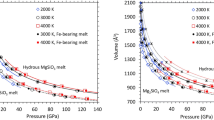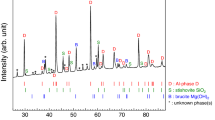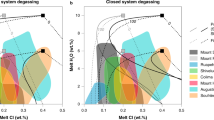Abstract
Understanding of the crystal chemistry of the Earth's deep mantle has evolved rapidly recently with the gradual acceptance of the importance of the effect of minor elements such as aluminium on the properties of major phases such as perovskite1,2,3. In the early Earth, during its formation and segregation into rocky mantle and iron-rich core, it is likely that silicate liquids played a large part in the transport of volatiles to or from the deep interior. The importance of aluminium on solubility mechanisms at high pressure has so far received little attention, even though aluminium has long been recognized as exerting strong control on liquid structures at ambient conditions4,5,6. Here we present constraints on the solubility of argon in aluminosilicate melt compositions up to 25 GPa and 3,000 K, using a laser-heated diamond-anvil cell. The argon contents reach a maximum that persists to pressures as high as 17 GPa (up to 500 km deep in an early magma ocean), well above that expected on the basis of Al-free melt experiments. A distinct drop in argon solubility observed over a narrow pressure range correlates well with the expected void loss in the melt structure predicted by recent molecular dynamics simulations7,8,9. These results provide a process for noble gas sequestration in the mantle at various depths in a cooling magma ocean. The concept of shallow partial melting as a unique process for extracting noble gases from the early Earth, thereby defining the initial atmospheric abundance, may therefore be oversimplified.
This is a preview of subscription content, access via your institution
Access options
Subscribe to this journal
Receive 51 print issues and online access
$199.00 per year
only $3.90 per issue
Buy this article
- Purchase on Springer Link
- Instant access to full article PDF
Prices may be subject to local taxes which are calculated during checkout




Similar content being viewed by others
References
Wood, B. J. & Rubie, D. C. The effect of alumina on phase transformations at the 660-kilometer discontinuity from Fe-Mg partitioning experiments. Science 273, 1522–1524 (1996)
Brodholt, J. P. Pressure-induced changes in the compression mechanism of aluminous perovskite in the Earth's mantle. Nature 407, 620–622 (2000)
McCammon, C. The paradox of mantle redox. Science 308, 807–808 (2005)
Yarger, J. et al. Al coordination changes in high-pressure aluminosilicate liquids. Science 270, 1964–1967 (1995)
Poe, B. T. et al. Silicon and oxygen self-diffusivities in silicate liquids measured to 15 gigapascals and 2800 Kelvin. Science 276, 1245–1248 (1997)
Mysen, B. O. & Richet, P. Silicate Glasses and Melts, Properties and Structure 231–290 (Elsevier, Amsterdam, 2005)
Nevins, D. & Spera, F. J. Molecular dynamics simulations of molten CaAl2Si2O8: Dependence of structure and properties on pressure. Am. Mineral. 83, 1220–1230 (1998)
Rustad, J. R., Yuen, D. A. & Spera, F. J. Molecular dynamics of liquid SiO2 under high pressure. Phys. Rev. A. 42, 2081–2089 (1990)
Trave, A., Tangney, P., Scandolo, S., Pasquarello, A. & Car, R. Pressure-induced structural changes in liquid SiO2 from ab-initio simulations. Phys. Rev. Lett. 89, 245504 (2002)
Ozima, M. & Podosek, F. A. Noble Gas Geochemistry Edn 2 (Cambridge Univ. Press, Cambridge, 2002)
Pepin, R. O. On the origin and early evolution of terrestrial planet atmospheres and meteoritic volatiles. Icarus 92, 2–79 (1991)
Tonks, W. B. & Melosh, H. J. Magma ocean formation due to giant impacts. J. Geophys. Res. 98, 5319–5333 (1993)
Jephcoat, A. P. & Besedin, S. in Properties of Earth and Planetary Materials at High Pressure and Temperature. Geophys. Monogr. 101, 287 (1998)
Bouhifd, M. A. & Jephcoat, A. P. The effect of pressure on partitioning of Ni and Co between silicate and iron-rich metal liquids: a diamond-anvil cell study. Earth Planet. Sci. Lett. 209, 245–255 (2003)
Jephcoat, A. P., Mao, H. K. & Bell, P. M. in Hydrothermal Experimental Techniques 469–506 (Wiley-Interscience, New York, 1987)
Poe, B. T., Romano, C., Zotov, N., Cibin, G. & Marcelli, A. Compression mechanisms in aluminosilicate melts: Raman and XANES spectroscopy of glasses quenched from pressures up to 10 GPa. Chem. Geol. 174, 21–31 (2001)
Chamorro-Perez, E., Gillet, P., Jambon, A., Badro, J. & McMillan, P. Low argon solubility in silicate melts at high pressure. Nature 393, 352–355 (1998)
White, B. S., Brearly, M. & Montana, A. Solubility of argon in silicate liquids at high pressures. Am. Mineral. 74, 513–529 (1989)
Chamorro-Perez, E., Gillet, P. & Jambon, A. Argon solubility in silicate melts at very high pressures. Experimental set-up and preliminary results for silica and anorthite melts. Earth Planet. Sci. Lett. 145, 97–107 (1996)
Carroll, M. R. & Stolper, E. M. Noble gas solubilities in silicate melts and glasses: New experimental results for argon and the relationship between solubility and ionic porosity. Geochim. Cosmochim. Acta 57, 5039–5051 (1993)
Thibault, Y. & Walter, M. J. The influence of pressure and temperature on the metal-silicate partition coefficients of nickel and cobalt in a model C1 chondrite and implications for metal segregation in a deep magma ocean. Geochim. Cosmochim. Acta 59, 991–1002 (1995)
Hiyagon, H. & Ozima, M. Partitioning of noble-gases between olivine and basalt melt. Geochim. Cosmochim. Acta 50, 2045–2057 (1986)
Jambon, A., Weber, H. & Braun, O. Solubility of He, Ne, Ar, Kr and Xe in a basalt melt in the range 1250–1600 °C. Geochemical implications. Geochim. Cosmochim. Acta 50, 401–408 (1986)
Lux, G. The behaviour of noble gases in silicate liquids: solution, diffusion, bubbles, and surface effects, with applications to natural samples. Geochim. Cosmochim. Acta 51, 1549–1560 (1987)
Allwardt, J. R., Stebbins, J. F., Burkhard, S. & Frost, D. J. in Frontiers in High-Pressure Research (eds Chen, J., Wang, Y., Duffy, T. S., Shen, G. & Dobrzhinetskaya, L. F.) 211–240, (2005)
Schmidt, B. C. & Keppler, H. Experimental evidence for high noble gas solubilities in silicate melts under mantle pressures. Earth Planet. Sci. Lett. 195, 277–290 (2002)
Shibata, T., Takahashi, E. & Matsuda, J. Solubility of neon, argon, krypton, and xenon in binary and ternary silicate systems: a new view on noble gas solubility. Geochim. Cosmochim. Acta 62, 1241–1253 (1998)
Brooker, R. A. et al. The 'zero charge' partitioning behaviour of noble gases during mantle melting. Nature 423, 738–741 (2003)
Allégre, C. J., Hofmann, A. & O'Nions, R. K. The argon constraints on mantle structure. Geophys. Res. Lett. 23, 3555–3557 (1996)
Acknowledgements
We thank P. Richet and D. Porcelli for their comments, P. Richet for donating the anorthite sample material, A. K. Kleppe and N. R. Charnley for their help during this work. M.A.B. acknowledges the earlier support of a Marie Curie EU Fellowship. This work was supported by NERC Grants to A.P.J.
Author information
Authors and Affiliations
Corresponding authors
Ethics declarations
Competing interests
Reprints and permissions information is available at npg.nature.com/reprintsandpermissions. The authors declare no competing financial interests.
Supplementary information
Supplementary Notes
This file contains Supplementary Methods, Supplementary Figures 1–6 and additional references.
Rights and permissions
About this article
Cite this article
Bouhifd, M., Jephcoat, A. Aluminium control of argon solubility in silicate melts under pressure. Nature 439, 961–964 (2006). https://doi.org/10.1038/nature04583
Received:
Accepted:
Issue Date:
DOI: https://doi.org/10.1038/nature04583
This article is cited by
-
Reconciling metal–silicate partitioning and late accretion in the Earth
Nature Communications (2021)
-
Helium in Earth’s early core
Nature Geoscience (2013)
-
Helium penetrates into silica glass and reduces its compressibility
Nature Communications (2011)
Comments
By submitting a comment you agree to abide by our Terms and Community Guidelines. If you find something abusive or that does not comply with our terms or guidelines please flag it as inappropriate.



